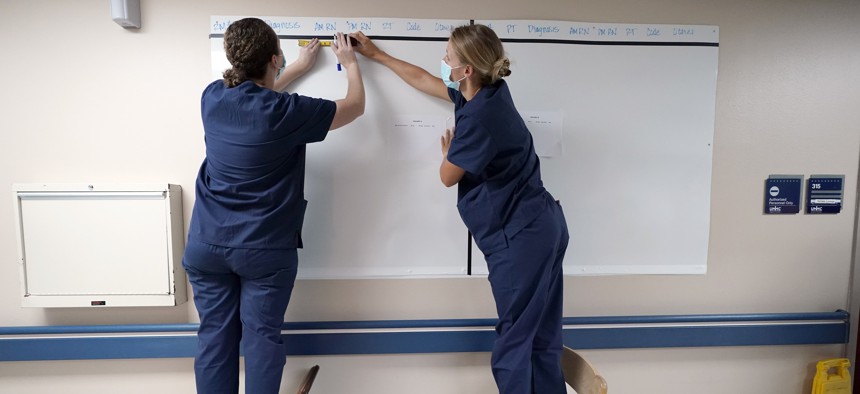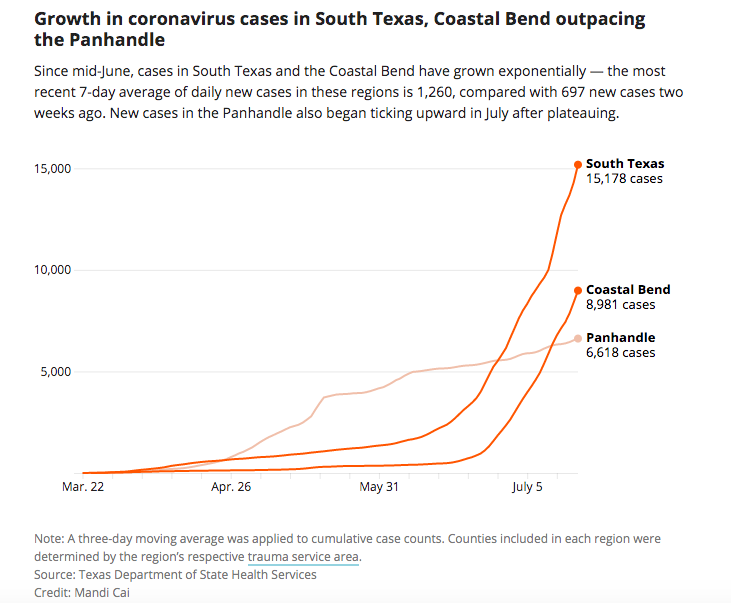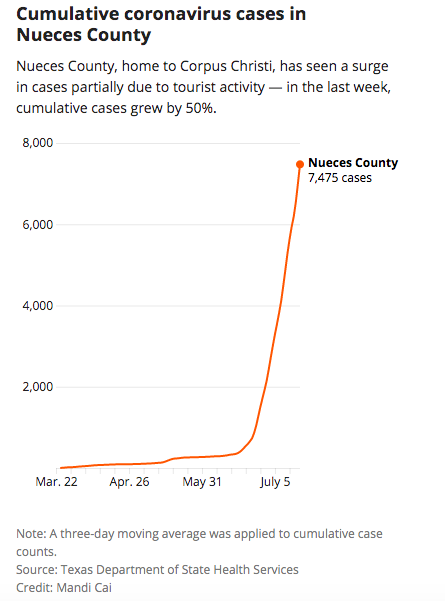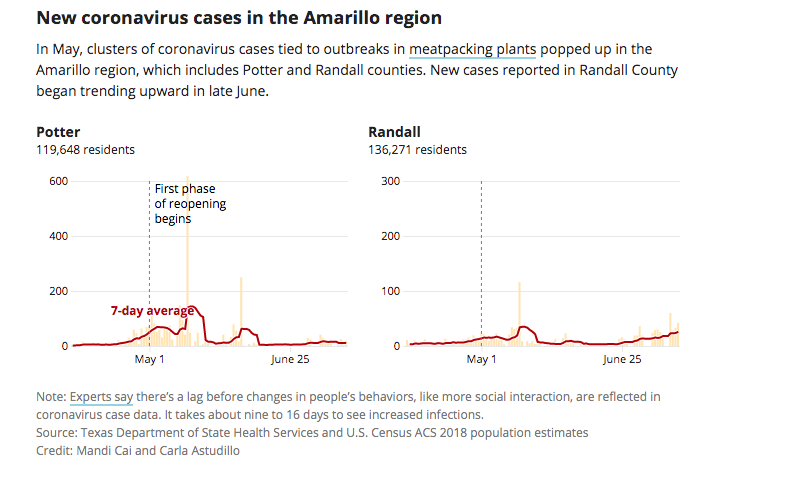With 4 in 5 Texans Living in a 'Red Zone,' Coronavirus Hot Spots Are Moving Targets

Registered nurses Army Capt. Rachel Curtis, right, and Capt. Christa Angelotti, with the Urban Augmentation Medical Task Force, sets up a patient board inside a wing at United Memorial Medical Center, Thursday, July 16, 2020, in Houston. AP Photo
Connecting state and local government leaders
Early hot spots have been eclipsed by new regions in crisis. Now that so much of Texas is battling major coronavirus outbreaks, some severely ill patients have to travel long distances to receive the care they need.
The trip from the Rio Grande Valley to the Panhandle is too far to make in a helicopter. So earlier this week, when an intubated COVID-19 patient left Harlingen, near the state’s southernmost tip, for Amarillo, its northernmost metro area, hospital officials sent a fixed-wing airplane.
The South Texas hospital, inundated with a surge of sick and dying coronavirus patients, had tried sending the severely ill patient to closer facilities—but Northwest Texas Healthcare System was “the first hospital between them and us” that had the capacity to take the patient, said Dr. Brian Weis, the Amarillo hospital’s chief medical officer.
The journey of some 700 miles highlights the urgency of the coronavirus pandemic in South Texas hospitals—and the huge variations across this sprawling state, where the scale of COVID-19 outbreaks varies as much from city to city as the climate.
Over the four months of Texas’ course of the coronavirus, early hot spots—Amarillo among them—have been eclipsed by new regions in crisis—now, South Texas. But now that so much of Texas is battling major coronavirus outbreaks, some severely ill patients have to travel long distances to receive the care they need. And perhaps most alarmingly, even some relatively better-off areas are inching further toward crisis.
Experts say instead of large clusters tied to specific, enclosed locations, like meatpacking plants or nursing homes, they are increasingly seeing smaller outbreaks out in the community. Small gatherings of families and friends and summer visitors to tourist destinations are spreading disease. That behavior, particularly among young people, may be responsible for dozens of new hot spots that will be more difficult to eradicate.
Stretches of South Texas, especially the Rio Grande Valley and the Coastal Bend, have seen coronavirus infections spread so quickly in recent weeks as to push local hospitals to their limit. The four-county region that includes Harlingen has just 21 ICU beds still available for a population of about 1.4 million people, according to the latest state data, and ambulance operators have described wait times of up to 10 hours to deliver patients to packed emergency rooms.

Nueces County, which includes Corpus Christi, has become emblematic of the recent, rapid surge. In the pandemic’s early days, while the Amarillo region battled some of the state’s largest early outbreaks, Nueces County stayed relatively healthy, reporting fewer than 100 cases and three deaths before Texas’ stay-at-home order expired on April 30. But now the popular beachfront location has one of the fastest-growing outbreaks in the state, adding well over 2,000 new cases for each of the past two weeks.
With 2% of the population infected, or one in every 50 people, Corpus Christi’s county has more cases per capita than Harris or Dallas counties. Visitors and tourists were the main drivers of the initial outbreak, local officials say, though researchers say it remains unknown why its case counts are higher than those of other busy beachfront destinations.
“I’m born and raised here, and I’ve never seen so many people coming here,” Nueces County Judge Barbara Canales said about May and June. She has restricted vehicle access to beaches and is asking visitors: “Let us heal and stabilize, we are at a critical breaking point.” There are still people gathering in restaurants and on beaches, which worries Annette Rodriguez, director of the Corpus Christi-Nueces County Public Health Department.
Rodriguez said she thinks it hasn’t hit some beachgoers that “this is a pandemic that could affect any one of them at any time.”
Last Friday, Nueces County Medical Examiner Adel Shaker was shocked to learn that a baby boy, less than 6 months old, had tested positive for COVID-19 and died shortly after.
“It’s not anything that anyone can be prepared to face, even with the best plan,” he said.
The same day, Shaker had requested an additional refrigerated truck to store bodies, while the county’s existing morgue was full. The mobile morgue is scheduled to arrive on Saturday, and will also house bodies from neighboring counties. Canales also wrote to the Texas Division of Emergency Management asking for additional staffing and personal protective equipment, as well as military resources, such as field hospitals.

“I'm more frustrated that I can't figure out how to make a difference, how to actually get individuals to pay attention,” Rodriguez said with a sigh. The county is 64% Hispanic, a higher proportion than the state average of 40%.
National data has shown that Black and Hispanic people are disproportionately affected by the virus. State data remains incomplete, but local snapshots indicate the trend is playing out in Texas, too. South Texas—currently the hardest-hit region of the state—has a larger share of Hispanic residents than many other regions.
In nearby Rockport, nearly one-quarter of the city staff—including the police chief—had tested positive for the virus on Thursday or was quarantining while awaiting test results, Mayor Pat Rios said. Local leaders have gone so far as to discourage tourists from visiting and close beaches to vehicles.
“It’s real painful,” said Aransas County Judge Burt Mills. “It’s a terrible thing to have to do … but I can only say that I’m trying to keep the people of Aransas County safe.”
Local hospital administrators say they’re optimistic that the rate of new hospitalizations is slowing, after taking extraordinary measures in recent weeks to expand ICU capacity, such as bringing in nurses from other parts of the state.
“We are hopeful that we are starting to experience that flattening,” said Dr. Sam Bagchi, chief clinical officer for CHRISTUS Health, the largest hospital system in the Coastal Bend.
But under projections from Chris Bird, a Texas A&M Corpus Christi life sciences professor who has modeled the region’s outbreak, local hospitals may need to make space for 140 more critically ill COVID-19 patients by Aug. 14.
As of Friday, there were only three ICU beds available in the 12-county region that includes Corpus Christi and serves more than 630,000 people. Canales said all the Coastal Bend hospitals are already in surge capacity.
The good news, according to Bird, is that cellphone tracking data indicates that residents and visitors are now venturing out less, likely slowing the rate of infection.
As of last week, the White House Coronavirus Task Force designated almost half of Texas’ 254 counties as “red zones”—an area that reports more than 100 new COVID-19 cases per 100,000 people in a single week, with at least 10% of tests coming back positive—according to a report obtained by the nonprofit Center for Public Integrity. Those 123 "red zone" counties are home to some 23 million Texans—the vast majority of the state's population.
That was a marked increase from the first week in July, when fewer than 90 Texas counties could be defined as “red zones.” The document, dated July 14, recommends that those areas mandate strict protective measures such as closing bars, gyms and limiting gatherings to 10 people or less.
Across Texas, only five counties—all of them rural and with fewer than 1,600 residents each—are still reporting no cases of COVID-19, a drop from 23 counties at the beginning of June.
Typically, rural and community hospitals transfer patients to urban hospitals for acute care. Now, “those transfer patterns have completely flipped,” said John Henderson, president of the Texas Organization of Rural and Community Hospitals, with smaller hospitals taking patients from urban centers.
In the Panhandle, the fear is that an early victory at reducing new daily infections may now give way to another outbreak. Amarillo—once a source of pride for state leaders, who said their “surge” efforts helped the area turn the corner—is bracing for a long outbreak as case counts begin to tick back up.

The Panhandle was one of the state’s early hot spots in the outbreak, with clusters of cases largely tied to prisons and cramped meatpacking factories, where a workforce of Hispanics and immigrants had little power to avoid the virus. The area’s peak came in mid-April, Weis said, when most of the people in his ICU had been infected at a correctional facility.
In early May, state officials sent a “surge team” of health officials and emergency response workers to the Panhandle, rapidly increasing testing and revealing hundreds of undiagnosed cases. Weeks later Gov. Greg Abbott hailed the operation as a success, boasting that Amarillo would be a model for the state’s COVID-19 response.
Case counts stayed low in June, but they’re now on the rise again in the perfectly rectangular counties that make up the Amarillo area. And instead of a few facilities, the sources of those infections are more widespread.
/https://static.texastribune.org/media/files/7cdbe4cf0d9079df034e3a7af3cb848b/COVID%20Amarillo%20MS%20TT%209428.jpg)
Amarillo Public Health Director Casie Stoughton said this week that “instead of one or two large outbreaks, we’re currently seeing many smaller clusters, indicating that we’re moving around quite a bit.” There are “lots and lots of gatherings,” she said, and young people are a major source of the spread.
“What we’re now seeing is true community-acquired COVID-19—which is almost more concerning,” said Weis, chief medical officer for the Northwest Texas Health System.
Two weeks ago, there were just seven positive COVID-19 patients in the Amarillo hospital; by this week, that had more than tripled to 24. Earlier this week, a patient in their 30s died; now, the family of a patient in their 40s is considering withdrawing care.
The hospital has not yet initiated a “surge” plan, an emergency step that would allow them to staff more beds than usual. Weis said the ICU is “tight.”
“The finish line is not close in sight,” Amarillo Mayor Ginger Nelson said this week at a city meeting.
This article originally appeared in The Texas Tribune at https://www.texastribune.org/2020/07/18/texas-coronavirus-hot-spots/.
The Texas Tribune is proud to celebrate 10 years of exceptional journalism for an exceptional state. Explore the next 10 years with us.

NEXT STORY: How Trump Closed Down the Schools


